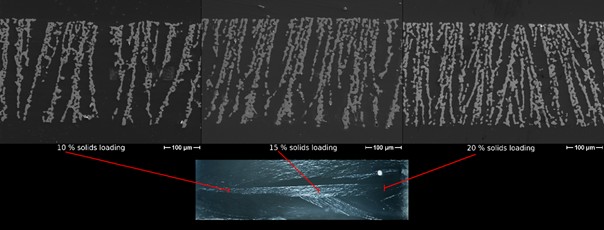Superior Separation Membranes for Fuel Cells, Batteries, CO2 Conversion, and Electrocatalysis
A new porous membrane fabrication technology optimizes performance and provides long term durability and sustained operation for membrane separation processes.
Background:
Advanced porous membrane technology shows great promise in a variety of green energy
and process separation applications such as fuel cells, batteries and conversion of
CO2 to valuable substrates. But, industrial scale up of such technologies has been
challenging. A key limitation is the inability to control and vary membrane pore
sizes and shapes throughout a commercial separation system. Montana State University
offers a new technology for controlling pore geometry throughout large stacks of membranes
to maximize separation performance, enhance membrane durability and enable sustained
performance of industrial separation systems.
Optimizing pore configuration in membranes has been partially achieved by a fabrication
technique known as tape casting, which enables manufacturing of thicker membranes
with shaped pore sizes that are graded in diameter over the depth of the membrane.
A graded pore can provide a more conical shape vs. tubular, which allows for an improved
microstructure for better flux and greater membrane strength. But such processes
have not allowed fabrication of porous gradients along the lateral direction of a
membrane which, in addition to the axial direction, is needed for optimal performance
and particularly for the demands of full-scale industrial processes with high throughput
and long membrane channels.
Solution:
The new MSU tape casting fabrication process simultaneously controls porosity size
and shape in both the axial and lateral channels of a membrane. This technique provides
a breakthrough in the manufacturing of porous membranes for improved efficiency at a
much larger scale than available with current membrane systems. This can eliminate
compromising high temperature or high pressure zones and allow optimal flux of process
chemistries throughout a commercial stacked porous membrane system.
The MSU process can greatly enhance the commercial potential of using porous membranes
in heterogeneous catalysis, fuel reformation, electrochemical energy conversion via
fuel cells or batteries, electrolysis and CO2 conversion. The MSU method also provides key manufacturing benefits in not requiring
thermal fugitives (polymer & carbon powder additions to form shape pores) and can
allow fabrication in an eco-friendly water-based process. The MSU researchers have
produced the multi-directional graded porous membranes in a range of materials including
polymers, ceramics, metals, and carbon-based substrates.
The new tape casting process has been validated in the laboratory and performance data is available. This establishes the process is at a technology readiness level (TRL) of 4. Most importantly, the technology can be implemented to move many promising porous membrane technologies to full scale operations, which has been a challenge for the membrane separation industry.

Figure 1: Freeze tape cast laterally graded membranes from 10 to 20 volume % solids loading as seen through cross-section SEM micrographs and backlight green cast tape (bottom).
Benefits:
- Optimized efficiency and sustained performance of commercial scale porous membrane systems
- Low-cost, eco-friendly, water-based process
- Applicable to many tape casting processes and materials
- Tunable to any engineering requirement for pore size and shapes in both axial and lateral directions of a membrane
- High durability by more evenly distributing reactions and reducing hot-spots within the membrane
- Stronger binding
Opportunity:
- MSU has filed for patent protection and is seeking proposals for licensing.
- MSU researchers are available to collaborate under a program funded by the U.S. Department of Energy.
Supporting IP:
- US20210162351 - CONTINUOUS LATERAL PORE GRADING FOR SCALABLE EFFICIENCY OF MEMBRANES)
Contact:
Nick Zelver
406‐994‐7706
nzelver@montana.edu
